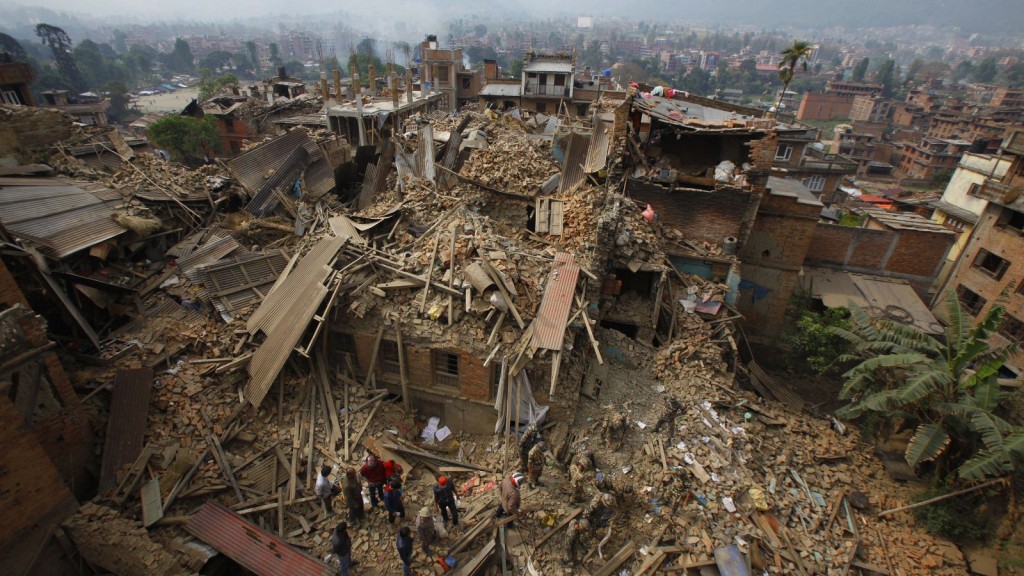- California Assembly OKs highest minimum wage in nation
- S. Korea unveils first graphic cigarette warnings
- US joins with South Korea, Japan in bid to deter North Korea
- LPGA golfer Chun In-gee finally back in action
- S. Korea won’t be top seed in final World Cup qualification round
- US men’s soccer misses 2nd straight Olympics
- US back on track in qualifying with 4-0 win over Guatemala
- High-intensity workout injuries spawn cottage industry
- CDC expands range of Zika mosquitoes into parts of Northeast
- Who knew? ‘The Walking Dead’ is helping families connect
Death toll from massive Nepal earthquake surpasses 4,000
KATHMANDU, Nepal (AP) — Officials say the death toll from massive Nepal earthquake has surpassed 4,000.
The desperate effort to save lives in earthquake-ravaged Nepal intensified Monday as aid flights arrived bearing emergency medical teams, search-and-rescue equipment, and tarps for shelter.
Governments, charities and development agencies also announced broader plans for further help set to arrive in the coming days and weeks.
Priority at the damaged international airport in the Nepalese capital Kathmandu was given to aid flights carrying either doctors or search teams, said Capt. Chezki, an Israeli air force pilot who landed an early aid flight and then returned to Israel. He could only be identified by his first name according to Israeli military guidelines.
He told The Associated Press that not every flight that wants to land can do so because of conditions at the airfield.
“It’s a challenge,” he said. “Not every plane is able to land and a lot of the airport was damaged.”
He said his squadron dropped off boxes with aid as quickly as possible and set up camp to help the injured before returning to Israel with some injured people who were medically cleared for travel.
Aid experts said disruptions at the airport are likely to continue, slowing the arrival and distribution of vitally needed supplies.
Kipp Branch, senior medical supply officer for the MAP International charity, said the group is putting together an extensive medical supply shipment that will only be sent once it has clearance to land and distribute emergency health supplies intended to support 10,000 people for three months.
“The challenge now is getting the airport up and running,” he said from Brunwsick, Georgia, in the United States, where he is organizing the shipment that will likely be sent from the Netherlands via a commercial cargo flight.
He said the huge amount of aid being sent means the airport will be challenged to accommodate all of the flights.
“The world is trying to respond, which is a good thing, and the systems and networks tend to work a little bit slower due to the traffic volume coming in,” he said.
The aid program is likely to be needed for an extended period of time.
The Asian Development Bank Monday announced a $3 million grant to Nepal and said an additional $200 million will be made available for rehabilitation projects needed to help rebuild the Himalayan country.
Spain’s government planned to send a chartered jet to Nepal loaded with tons of donated aid from the government and charities, including material to build water storage distribution points and latrines, tarps for shelters plus blankets and cooking sets for more than 500 families.
Mariona Minet of Spain’s Oxfam Intermon said many people are still frightened and sleeping on the streets.
“Right now, the main needs are rescuing people and supplying those affected with food, water and shelter,” she said.
“The government has asked them not to go back to their homes because there have been 65 aftershocks since the earthquake. Electricity and water are cut off, so supplying potable water is urgent.”
A British Royal Air Force plane loaded with aid was also expected to arrive in Nepal on Monday. British volunteers are already helping with search-and-rescue operations.
The Israeli military said three aid-filled planes have already left for Nepal and three more departures are planned in the near future.
Plans call for the military to set up a field hospital to perform lifesaving medical procedures as quickly as possible and also to try to locate and aid survivors who are still trapped.
















